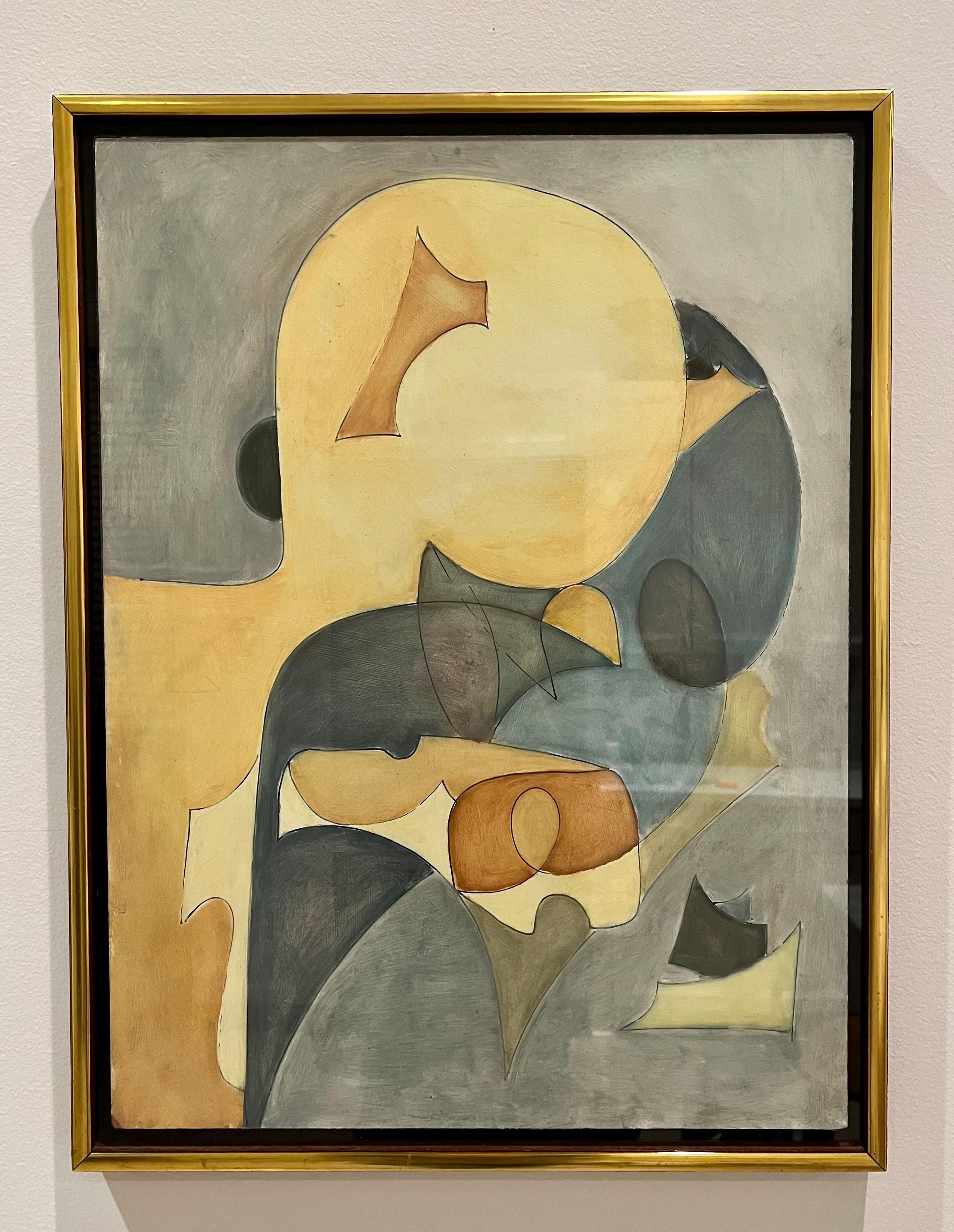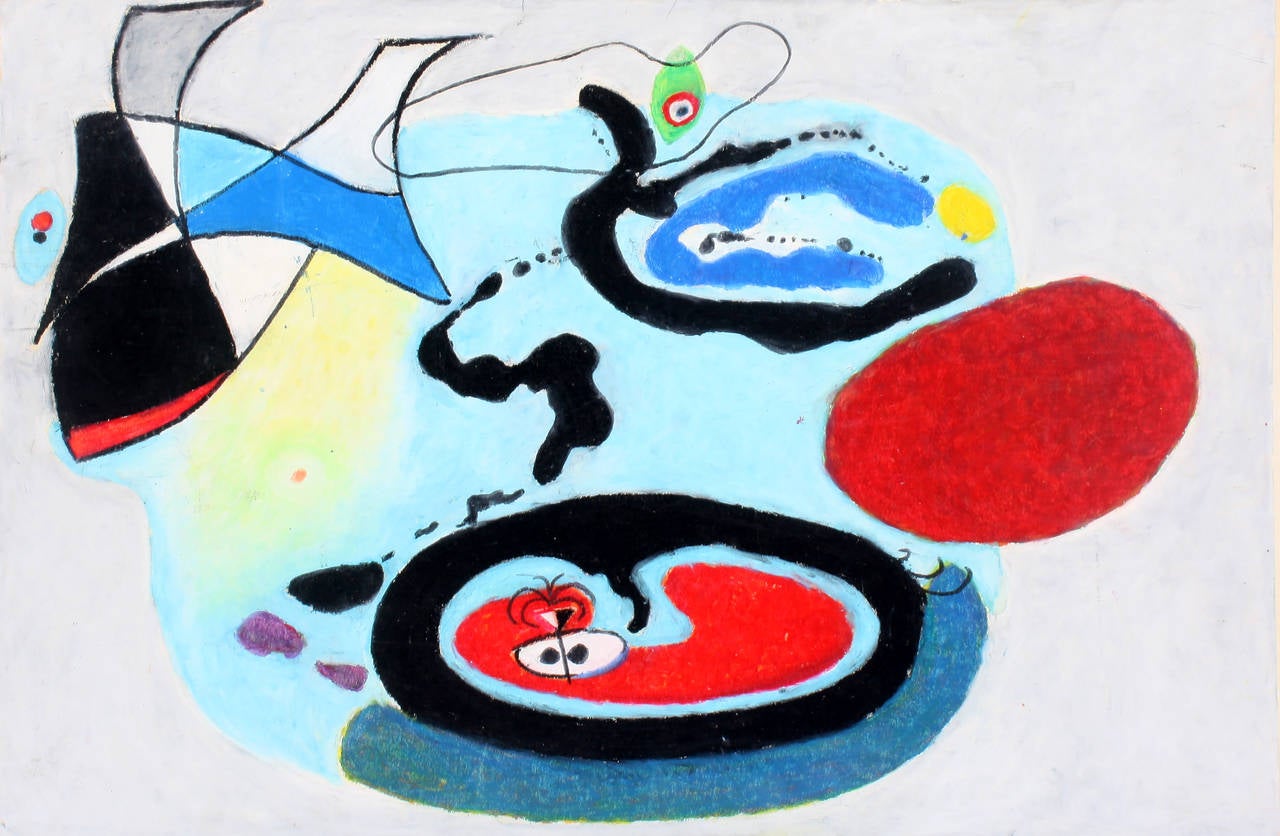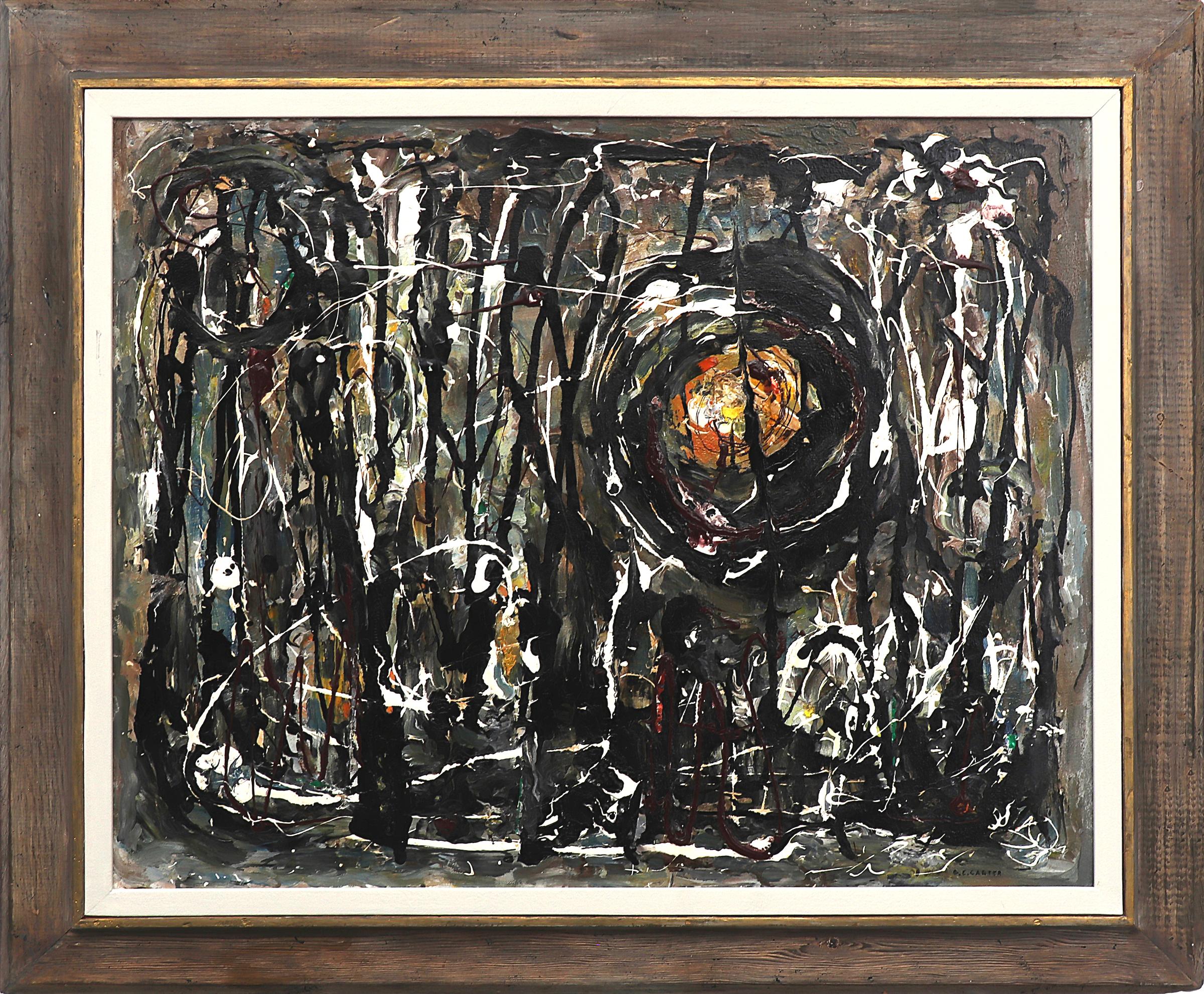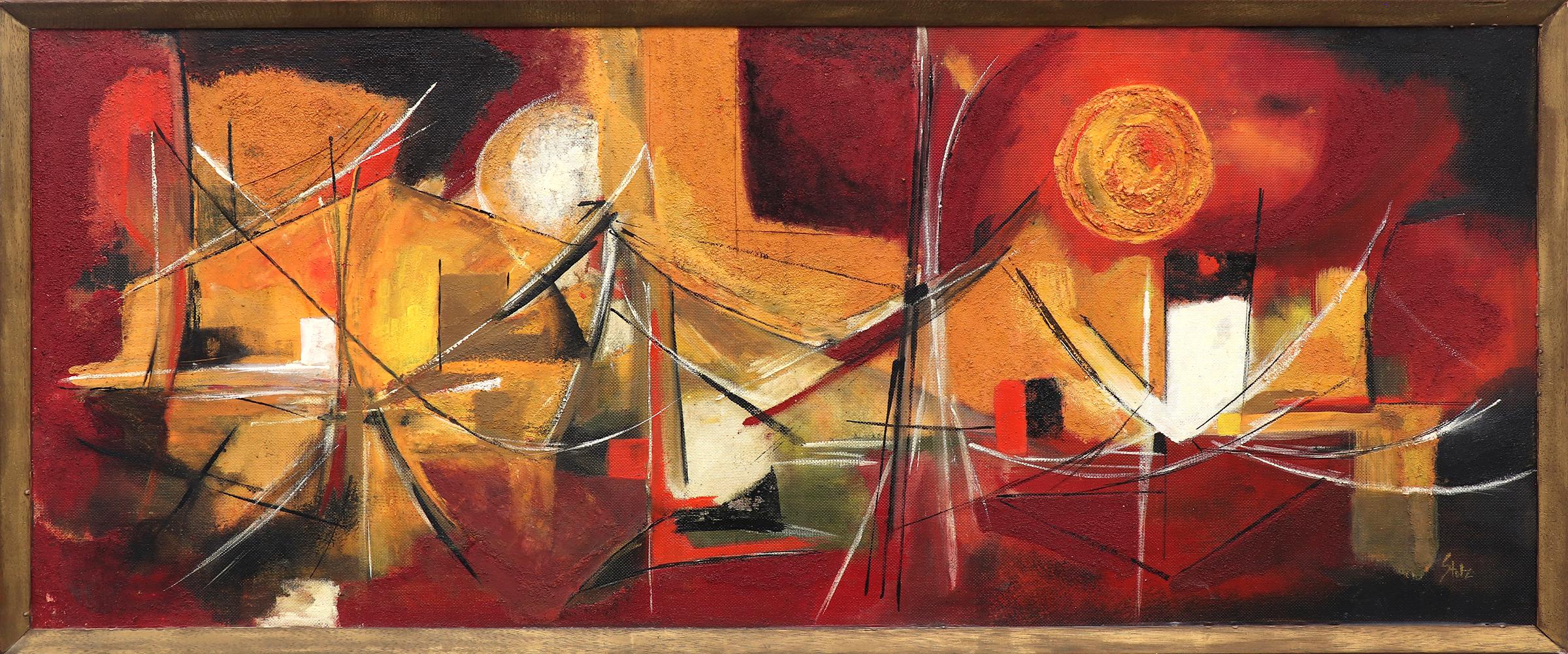Items Similar to Untitled (Biomorphic Composition)
Want more images or videos?
Request additional images or videos from the seller
1 of 6
Dave FoxUntitled (Biomorphic Composition)1948
1948
About the Item
This painting is part of our exhibition America Coast to Coast: Artists of the 1940s.
Untitled (Biomorphic Composition), 1948, oil on textured paper mounted on board, signed and dated lower right, 16 x 18 inches, presented in an original painted frame
Dave Fox was a Los Angeles-based painter and printmaker. He was born in Vienna, Austria in 1920 and lived there until the Nazi annexation when he sought refuge in Belgium. Fox then arrived in Los Angeles in 1939. With the advent of World War II, Fox joined the US Army and served in the Pacific Theater. After the War, Fox returned to Southern California and studied with Rico Lebrun, Frances de Erderly, and Guy McCoy, who introduced Fox to printmaking, including serigraphy. In the late 1940s, Fox also studied at the Bisttram School of Fine Art in Los Angeles which flourished between 1945 and the early 1950s. In his 1948 Untitled (Biomorphic Composition), Fox pays homage to the teachings of his instructor, Emil Bistrram, through his use of abstracted modernist forms which just barely hide their origins. After studying with Bisttram, Fox earned BFA, MA and MFA degrees from Cal State Fullerton. Fox’s oeuvre was varied and contained works that reflected his Jewish heritage, scenes of 1940s and 1950s Los Angeles, his recollections of Vienna, theater scenes, and modernist abstractions. In addition to his fine art practice, he worked as an artist and graphic designer for a Southern California electronics firm.
- Creator:Dave Fox (1920 - 2011, American, Austrian)
- Creation Year:1948
- Dimensions:Height: 16 in (40.64 cm)Width: 18 in (45.72 cm)Depth: 2 in (5.08 cm)
- More Editions & Sizes:16 x 18 inchesPrice: $4,750
- Medium:
- Movement & Style:
- Period:
- Condition:
- Gallery Location:Los Angeles, CA
- Reference Number:1stDibs: LU1859214281172
About the Seller
No Reviews Yet
Vetted Seller
These experienced sellers undergo a comprehensive evaluation by our team of in-house experts.
1stDibs seller since 2022
6 sales on 1stDibs
Typical response time: 6 hours
- ShippingRetrieving quote...Ships From: Los Angeles, CA
- Return PolicyA return for this item may be initiated within 3 days of delivery.
More From This SellerView All
- Energy Manifestation #4Located in Los Angeles, CAEnergy Manifestation #4, 1933, oil on canvas, 24 x 30 inches, signed and dated lower left. Likely exhibited at Nicolaides’ solo show at the Wadsworth Atheneum (Morgan Memorial Building), Hartford, Connecticut, in April, 1933 (see Memorial Opens Varied Display of Nicolaides Work, Originality Distinguishes Creations of New York City Artist, Hartford Courant, April 5, 1933) About the Painting This rare work comes from Nicolaides’ energy series, which draws on a unique combination of machine- age aesthetics, Italian-influenced Futurism and French-inspired Surrealism. But, this is a uniquely American work produced in the melting pot of the 1930s metropolis, New York City. Nicolaides uses the ray lines of the American precisionists to frame a pulsating apparatus that unites man and machine as one. The cogs and gears of the fantasy machine seamlessly blend with the hand of its operator. We are left to wonder whether the two are working together in harmony or whether the worker has been absorbed into the machine, like a Depression era robot. In reviewing the 1933 Wadsworth Atheneum show, where works from Nicolaides’ energy series were exhibited, a critic described these paintings as “combining . . . highly imaginative form aspects of machinery and flashes of color which seem to represent light and heat.” The same critic praised the artist, “Mr. Nicolaides here achieves powerful effects with line, mass and color. These pictures are striking for the solidity of the objects portrayed, for their composition and for their delicate orchestration of tones.” Commenting on the same exhibition, Frederick Hynd, the director of the Hartford Art School, noted that “Mr. Nicolaides’ work was noteworthy for its extremely personal sense of color and for its imagination” and that the artist achieved decorative effects “based on emotional ideas.” About the Artist Kimon Nicolaides...Category
1930s American Modern Abstract Paintings
MaterialsOil
- Amish Farmscape #3By Edmund LewandowskiLocated in Los Angeles, CAAmish Farmscape #3, 1984, oil on canvas, 40 x 30 inches, signed and dated lower right; signed, dated, and titled verso About the Painting Amish Farmscape #3 is part of a multi-painting series of barns completed in the early 1980s for an exhibition at New York’s prestigious Sid Deutsch Gallery. Lewandowski painted this work at an important point in his career. It was the first major project undertaken by Lewandowski after his retirement from serving as the Chairman of Winthrop University’s Art Department, the last academic position he held after teaching for nearly thirty years. Lewandowski had been inspired to work on the series by a visit to Lancaster County, Pennsylvania. Like his friend and mentor, Charles Sheeler, Lewandowski had always been fascinated by vernacular architecture and the Amish barns of Pennsylvania brought back memories of rural scenes Lewandowski had painted in the Midwest much earlier in his career. Amish Farmscape #3 is a strong example of Lewandowski’s late precisionist work. The complexity of the composition and Lewandowski’s technical acumen are on full display. Being relieved of the burdens of teaching and administering a university art department likely allowed Lewandowski greater freedom and most importantly more time to complete the Amish Farmscape series. Although Lewandowski’s brand of precisionism changed throughout the years, he never deviated from the core tenets of the Immaculate School artists. In this work, we see simplified and flattened forms, the use of ray-lines to define light and space, the elimination of extraneous details, a polished almost machine-like finish, and the complete lack of visible brushstrokes, all hallmarks of the precisionist painters. Lewandowski was the last of the 20th century precisionists and in Amish Farmscape #3, we see just how successfully he continued to work in this style until his death in 1998. About the Artist Edmund Lewandowski was among the best of the second-generation precisionist painters. He was born and raised in Milwaukee, Wisconsin and studied at the Layton School of Art with Garrett Sinclair. Lewandowski achieved early success when in 1936 two of his watercolors were shown at the Phillips Collection as part of a Federal Art Project exhibition. Then, in 1937, his work was first exhibited at Edith Halpert’s Downtown Gallery which represented Lewandowski into the 1950s. Under Halpert’s guidance, Lewandowski continued to explore watercolor as his main medium during the 1930s and 1940s, since the gallery already represented Charles Sheeler, who worked primarily in oils. Sheeler became Lewandowski’s major influence as the primary leader of the ill-defined, but very recognizable Immaculate School artists, which included other Downtown Gallery painters, Niles Spencer, George Ault, and Ralston Crawford, as well as Charles Demuth and Preston Dickinson, both of whom died at a young age and had been represented by the Charles Daniel Gallery. Sheeler is credited with giving Lewandowski technical advice on how to make his paintings more precise and tightly rendered and by all accounts, Sheeler was a fan of Lewandowski’s work. Through the Downtown Gallery, Lewandowski’s paintings were accepted into major national and international exhibitions and purchased by significant museums and collectors. Franklin and Eleanor Roosevelt and Nelson Rockefeller acquired works by Lewandowski. He was included in the Museum of Modern Art’s important 1943 exhibition, American Realists and Magic Realists as well as juried exhibitions at the Whitney Museum of American Art, the Pennsylvania Academy of Fine Arts, and the Art Institute of Chicago. Lewandowski also completed commissions for magazines during the 1940s and 1950s, including several covers for Fortune. Throughout his career, Lewandowski explored urban and rural architecture, industry, machinery, and nautical themes. Looking back on his career, Lewandowski wrote, “My overwhelming desire as an artist through the years has been to record the beauty of man-made objects and energy of American industry on canvas. For as far back as I can recall, the cityscapes, farms and depictions of industrial power and technological efficiency has had a great attraction for me. I try to treat these observations with personal honesty and distill these impressions to a visual order.” Lewandowski is credited with extending precisionism to the Midwest and successfully continuing the style into the 1990s, three decades after Sheeler’s death and six decades after Demuth’s passing. Late in his career, Lewandowski enjoyed a resurgence of popularity as he was represented during the 1980s by New York’s Sid Deutsch and Allison Galleries...Category
Mid-20th Century American Modern Landscape Paintings
MaterialsCanvas, Oil
- Abstract Street (Untitled)By Hananiah HarariLocated in Los Angeles, CAThis painting is part of our exhibition America Coast to Coast: Artists of the 1930s Abstract Street (Untitled), 1939, oil on canvas, signed and dated lower right, 12 x 32 inches; provenance includes a private collection in Venice, California; presented in what is likely the artist's original handmade frame About the Painting The present work is the culmination of a series of mainly horizontal urban abstractions Harari completed between 1937 and 1939. Deeply influenced by Stuart Davis, Harari’s New York streetscapes began with clearly recognizable objects and landmarks as in Into New York (1937 - Collection of the Whitney Museum of American Art), New York Harbor (1937), Up and Downtown (1938), and his other mural proposals for the Nurses Home on Welfare Island (1937) and the Williamsburg Housing Project (1938). At the end of the series, Harari’s vistas became increasingly abstract with broad planes of color representing buildings and streets, the slightest cross-hatching forming a bridge or elevated train track and the vague suggestion of a streetlight looping in the right center of the composition. Figures, birds, and a street vendor’s cart are reduced to pictograms scratched into the surface of the canvas. Abstract Street (Untitled) is among Harari’s most spare works of the 1930s and 1940s and calls to mind the seemingly childlike, but deeply sophisticated works of Paul Klee from the 1920s. It serves as an excellent reminder of why Harari was heralded as one of the earliest members of the American Abstract Artists. About the Artist Hananiah Harari was an artistic polyglot who was equally at home working in styles as diverse as Cubism, Constructivism, Expressionism, Hard Edged Abstraction and trompe l’oeil Realism. A native of Rochester, New York, Harari initially studied as a child at the Memorial Art Gallery in his hometown and later as a scholarship student at the College of Fine Arts at Syracuse University. In 1932, Harari left for Paris where he befriended Nahum Tschacbasov, Benjamin Benno and John Graham and studied at the ateliers of Lhote, Leger and Gromaire. He also studied fresco painting at the Ecole de Fresque. By 1933, Harari had completed enough work and gained a sufficient reputation to have a solo exhibition at the American Club in Paris. The following year, Harari and his childhood friend and fellow artist Herzl Emanuel traveled to Palestine, where the artists worked hard in the orchards and fields of Kibbutz Deganiah, but produced little art. After returning to New York, Harari married Emanuel’s sister, Freda, and set out on the development of what noted scholar Gail Stavitsky has called an “original synthesis of the old and new." Harari became an early member of the American Abstract Artists (AAA), an organization formed to give modernists exhibition opportunities. Harari was also a member of the socially conscious Artist’s Union and the American Artist’s Congress. From 1936 through 1942, Harari worked on the Federal Art Project and assisted Marion Greenwood on a project as part of the Mural Division, but to his disappointment did not lead his own project. During the late 1930s and early 1940s, Harari completed a series of paired paintings with the same subject matter depicted in a Cubist manner and in trompe l’oeil Realism. Harari was acclaimed by Clement Greenberg and six of the artist’s works were selected for the Museum of Modern Art’s important 1943 exhibition American Realists and Magic Realists. During World War II, Harari served in the US Army Air Corps. Following the war, Harari continued to produce fine art while also producing commercial art. During the McCarthy Era, Harari’s progressive politics and leftist leaning art...Category
1930s American Modern Abstract Paintings
MaterialsOil
- Homage to LegerBy Jean KelloggLocated in Los Angeles, CAThis painting is part of our exhibition America Coast to Coast: Artists of the 1940s. Homage to Leger, 1941, oil on canvas, signed and dated lower right, 14 x 17 inches; inscribed ...Category
1940s American Modern Paintings
MaterialsCanvas, Oil
- Untitled (Cubist Portrait)By Jerre H. MurryLocated in Los Angeles, CAThis work is part of our exhibition - America Coast to Coast: Artists of the 1940s Untitled (Cubist Portrait), 1945, oil on masonite, signed and dated lower middle, 20 x 16 inches,...Category
1940s American Modern Paintings
MaterialsOil, Masonite
- The OrchestraLocated in Los Angeles, CAThe Orchestra, 1950, oil on canvas, 21 ½ x 25 3/4 inches, signed and dated lower left, labeled verso “Brown University, Trustee, The Walter Feldman Trus...Category
Mid-20th Century American Modern Abstract Paintings
MaterialsCanvas, Oil
You May Also Like
- American School, Abstract UntitledLocated in New Orleans, LAAmerican School, Artist UnknownCategory
Early 20th Century American Modern Abstract Paintings
MaterialsOil, Board
- UntitledLocated in Buffalo, NYAn unsigned mid century modern American abstract paintingCategory
1950s American Modern Abstract Paintings
MaterialsBoard, Illustration Board, Oil
- Head to Sea, Modernist sailing sceneBy Ralph Eugene Della-VolpeLocated in Greenwich, CTA vibrant and yet romantic sailing scene which was a favorite series by Della-Volpe. His compelling colorist approach has made his works desirable as he was one of the few artists post-war to be representative in style like Milton Avery and Wolf Kahn. Head to Sea has the hallmark intense and lovely coloration for which Della-Volpe is known. He came out of Abstract Expressionism in the New York school but then pivoted, like Milton Avery to representational, colorist work. The frame is a silvered gold leaf float frame of quality and has a rubbed, antiqued surface...Category
Early 2000s American Modern Abstract Paintings
MaterialsOil, Board
- Vintage Expressionist Portrait of a Man with a Bowtie Oil on WoodBy Michael PaukerLocated in Soquel, CAExpressive portrait, a caricature of a man with bowtie by Michael Pauker (American, b. 1957). Unsigned, but was acquired with a collection of the artist's work. Another version of th...Category
Late 20th Century American Modern Figurative Paintings
MaterialsOil, Fiberboard
- Warlock, 1950s Signed Abstract Oil Painting, Black, White, Gray, Orange, PurpleLocated in Denver, COOriginal oil and metal foil on board abstract painting by George Cecil Carter (1908-1987) circa 1950s. Signed by the artist in the lower right corner, titled and dated verso. Painted in shades of dark blue, gray, white, orange, and purple. Presented in an original George Nix frame measuring 30 ¾ x 36 ¾ inches. Image size measures 23 ¼ x 29 ¼ inches. About the Artist: Born 1908, Woodward, Oklahoma Died 1987, Canon City, Colorado George Cecil Carter was born in Oklahoma in 1908 and became a noted Colorado abstract expressionist, despite having no formal training. He worked as a coal miner, gold miner, and machinist at Schneebeck’s Industries in Colorado Springs for twenty years During that time, Carter worked on his art and was was mentored by Broadmoor Academy painter, Charles Bunnell. Carter worked out of Colorado Springs and Canon City, Colorado. He exhibited nationally, including Texas and Illinois. Among his contemporaries are Al Wynne, Mary Chenoweth...Category
1950s American Modern Abstract Paintings
MaterialsFoil
- Mid Century Modern Abstracted Cityscape Oil Painting, American Modern, Red BlackLocated in Denver, COMid 20th century oil and spackle painting featuring an abstracted cityscape with a bridge and buildings by Henriette "Yetti" Stolz. Signed by the artist in the lower right margin. Pa...Category
Mid-20th Century American Modern Abstract Paintings
MaterialsOil, Board, Putty
Recently Viewed
View AllMore Ways To Browse
Joshua Meador Painting
Marjorie Ruth Colbus
Poster David Pollack
Portrait Of A Naval Officer
I Know Where Im Going
Picasso Portrait Of A Lady
Bishop Crosses
One Light Intelligent
Royal Navy Ship Painting
J G Casas
Steve Wynn
Dior Ross
Las Vegas Travel
Mosaic Tiles Framed Art
Naive American Folk Art
Sharon Stone Artwork
A Clerget
St Louis Federal





